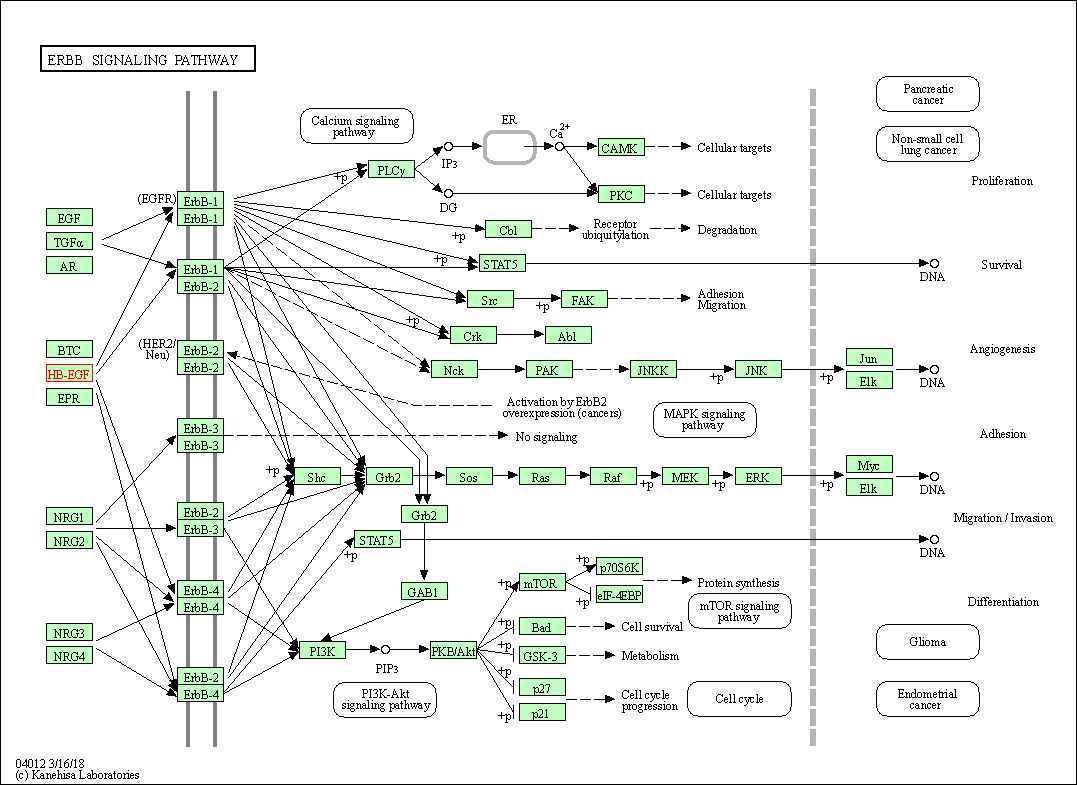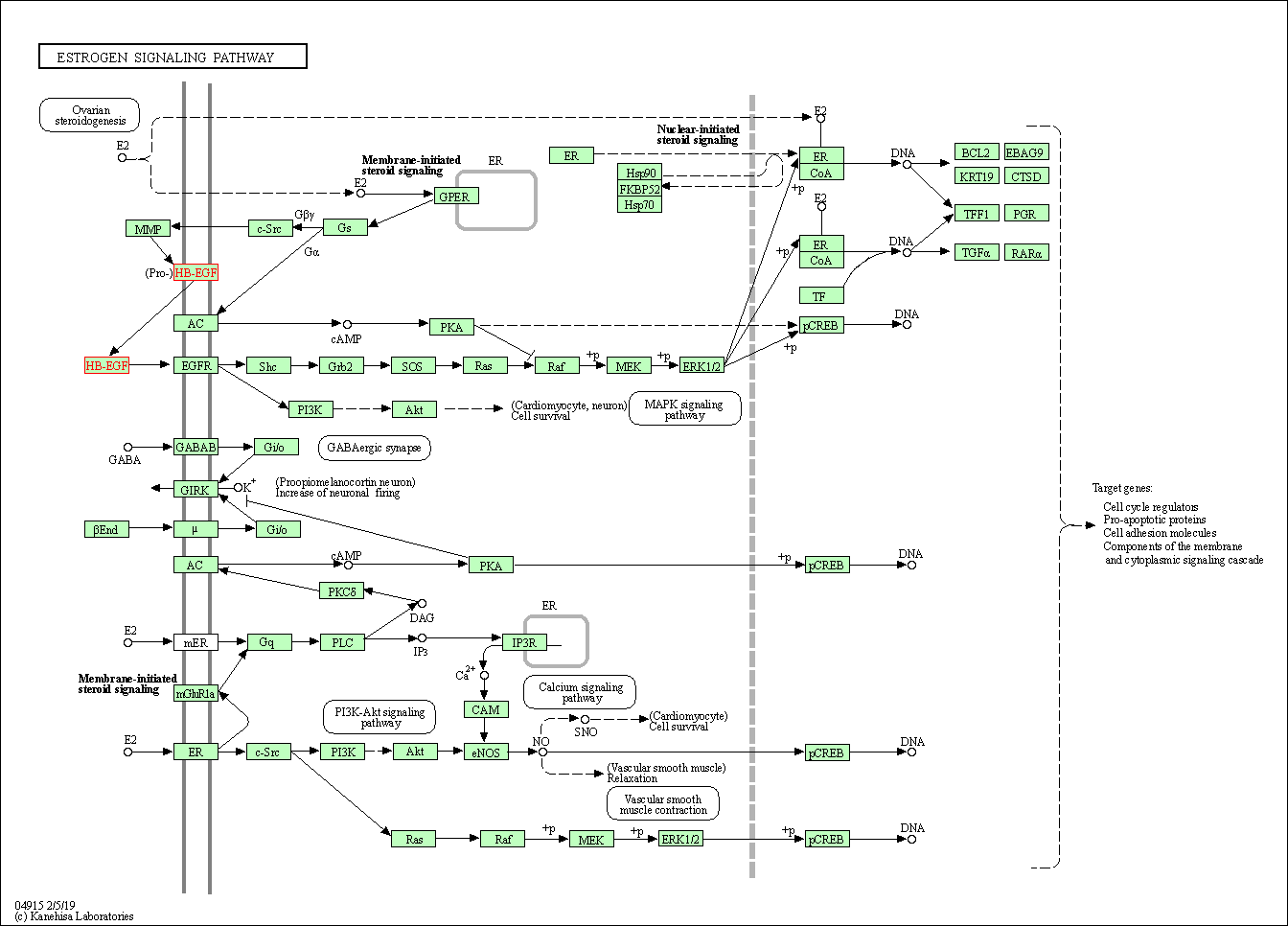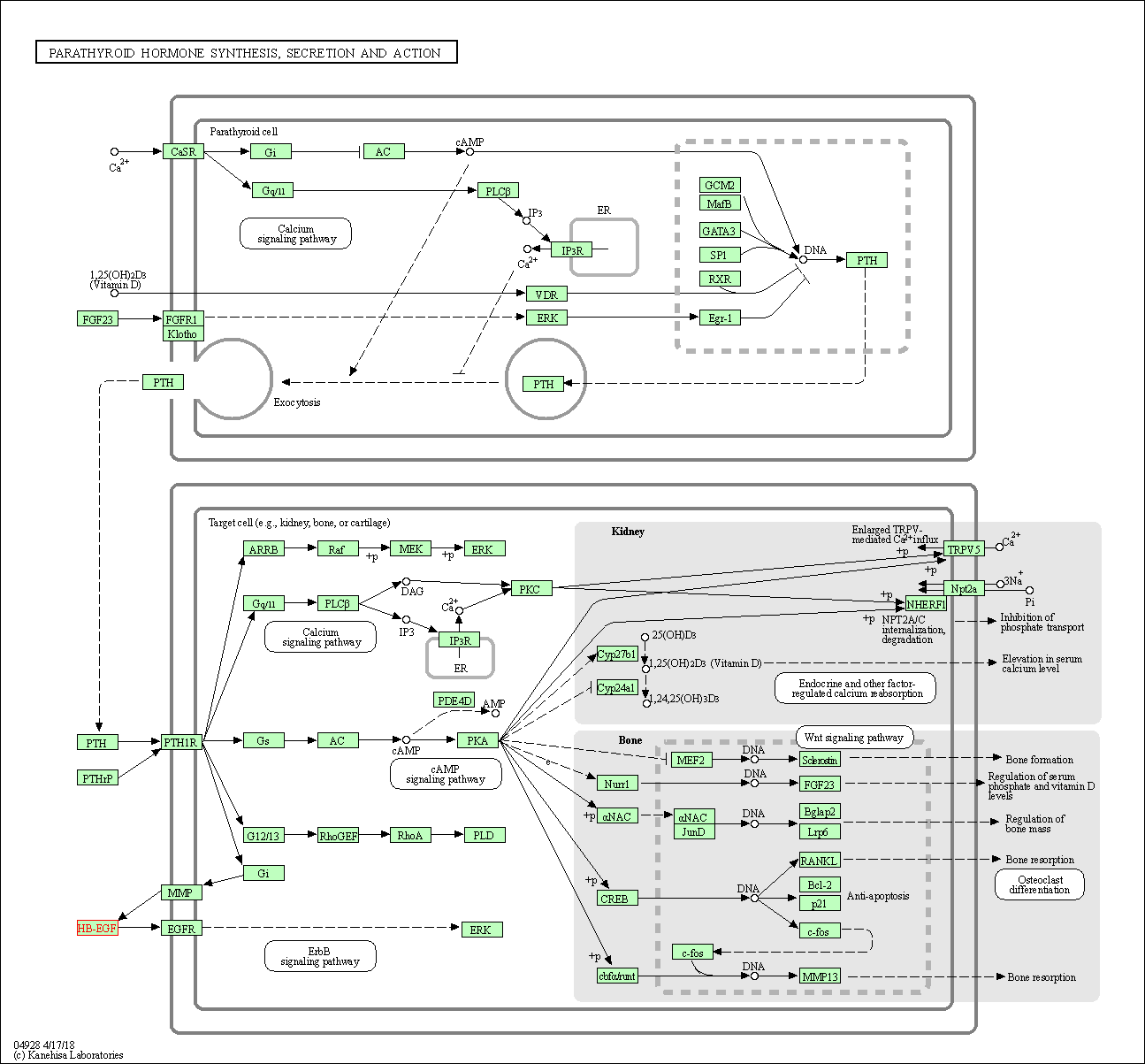Target Information
| Target General Information | Top | |||||
|---|---|---|---|---|---|---|
| Target ID |
T76093
(Former ID: TTDNC00420)
|
|||||
| Target Name |
Proheparin-binding EGF-like growth factor (HBEGF)
|
|||||
| Synonyms |
Proheparinbinding EGFlike growth factor; Heparinbinding EGFlike growth factor; Heparin-binding EGF-like growth factor; HEGFL; HB-EGF; Diphtheria toxin receptor; DTS; DTR; DT-R
Click to Show/Hide
|
|||||
| Gene Name |
HBEGF
|
|||||
| Target Type |
Clinical trial target
|
[1] | ||||
| Disease | [+] 3 Target-related Diseases | + | ||||
| 1 | Chronic tympanic membrane perforation ICD-11: AB13 | |||||
| 2 | Ovarian cancer [ICD-11: 2C73] | |||||
| 3 | Solid tumour/cancer [ICD-11: 2A00-2F9Z] | |||||
| Function |
Required for normal cardiac valve formation and normal heart function. Promotes smooth muscle cell proliferation. May be involved in macrophage-mediated cellular proliferation. It is mitogenic for fibroblasts, but not endothelial cells. It is able to bind EGF receptor/EGFR with higher affinity than EGF itself and is a far more potent mitogen for smooth muscle cells than EGF. Also acts as a diphtheria toxin receptor. Growth factor that mediates its effects via EGFR, ERBB2 and ERBB4.
Click to Show/Hide
|
|||||
| BioChemical Class |
Growth factor
|
|||||
| UniProt ID | ||||||
| Sequence |
MKLLPSVVLKLFLAAVLSALVTGESLERLRRGLAAGTSNPDPPTVSTDQLLPLGGGRDRK
VRDLQEADLDLLRVTLSSKPQALATPNKEEHGKRKKKGKGLGKKRDPCLRKYKDFCIHGE CKYVKELRAPSCICHPGYHGERCHGLSLPVENRLYTYDHTTILAVVAVVLSSVCLLVIVG LLMFRYHRRGGYDVENEEKVKLGMTNSH Click to Show/Hide
|
|||||
| 3D Structure | Click to Show 3D Structure of This Target | AlphaFold | ||||
| Drugs and Modes of Action | Top | |||||
|---|---|---|---|---|---|---|
| Clinical Trial Drug(s) | [+] 3 Clinical Trial Drugs | + | ||||
| 1 | ASP0598 | Drug Info | Phase 1 | Chronic tympanic membrane perforation | [2] | |
| 2 | KHK-2866 | Drug Info | Phase 1 | Ovarian cancer | [1] | |
| 3 | U3-1565 | Drug Info | Phase 1 | Solid tumour/cancer | [3] | |
| Mode of Action | [+] 2 Modes of Action | + | ||||
| Replacement | [+] 1 Replacement drugs | + | ||||
| 1 | ASP0598 | Drug Info | [2] | |||
| Modulator | [+] 1 Modulator drugs | + | ||||
| 1 | U3-1565 | Drug Info | [4] | |||
| Cell-based Target Expression Variations | Top | |||||
|---|---|---|---|---|---|---|
| Cell-based Target Expression Variations | ||||||
| Different Human System Profiles of Target | Top |
|---|---|
|
Human Similarity Proteins
of target is determined by comparing the sequence similarity of all human proteins with the target based on BLAST. The similarity proteins for a target are defined as the proteins with E-value < 0.005 and outside the protein families of the target.
A target that has fewer human similarity proteins outside its family is commonly regarded to possess a greater capacity to avoid undesired interactions and thus increase the possibility of finding successful drugs
(Brief Bioinform, 21: 649-662, 2020).
Human Tissue Distribution
of target is determined from a proteomics study that quantified more than 12,000 genes across 32 normal human tissues. Tissue Specificity (TS) score was used to define the enrichment of target across tissues.
The distribution of targets among different tissues or organs need to be taken into consideration when assessing the target druggability, as it is generally accepted that the wider the target distribution, the greater the concern over potential adverse effects
(Nat Rev Drug Discov, 20: 64-81, 2021).
Human Pathway Affiliation
of target is determined by the life-essential pathways provided on KEGG database. The target-affiliated pathways were defined based on the following two criteria (a) the pathways of the studied target should be life-essential for both healthy individuals and patients, and (b) the studied target should occupy an upstream position in the pathways and therefore had the ability to regulate biological function.
Targets involved in a fewer pathways have greater likelihood to be successfully developed, while those associated with more human pathways increase the chance of undesirable interferences with other human processes
(Pharmacol Rev, 58: 259-279, 2006).
Biological Network Descriptors
of target is determined based on a human protein-protein interactions (PPI) network consisting of 9,309 proteins and 52,713 PPIs, which were with a high confidence score of ≥ 0.95 collected from STRING database.
The network properties of targets based on protein-protein interactions (PPIs) have been widely adopted for the assessment of target’s druggability. Proteins with high node degree tend to have a high impact on network function through multiple interactions, while proteins with high betweenness centrality are regarded to be central for communication in interaction networks and regulate the flow of signaling information
(Front Pharmacol, 9, 1245, 2018;
Curr Opin Struct Biol. 44:134-142, 2017).
Human Similarity Proteins
Human Tissue Distribution
Human Pathway Affiliation
Biological Network Descriptors
|
|
|
Note:
If a protein has TS (tissue specficity) scores at least in one tissue >= 2.5, this protein is called tissue-enriched (including tissue-enriched-but-not-specific and tissue-specific). In the plots, the vertical lines are at thresholds 2.5 and 4.
|
| KEGG Pathway | Pathway ID | Affiliated Target | Pathway Map |
|---|---|---|---|
| ErbB signaling pathway | hsa04012 | Affiliated Target |

|
| Class: Environmental Information Processing => Signal transduction | Pathway Hierarchy | ||
| GnRH signaling pathway | hsa04912 | Affiliated Target |

|
| Class: Organismal Systems => Endocrine system | Pathway Hierarchy | ||
| Estrogen signaling pathway | hsa04915 | Affiliated Target |

|
| Class: Organismal Systems => Endocrine system | Pathway Hierarchy | ||
| Parathyroid hormone synthesis, secretion and action | hsa04928 | Affiliated Target |

|
| Class: Organismal Systems => Endocrine system | Pathway Hierarchy | ||
| Degree | 8 | Degree centrality | 8.59E-04 | Betweenness centrality | 5.95E-05 |
|---|---|---|---|---|---|
| Closeness centrality | 2.26E-01 | Radiality | 1.40E+01 | Clustering coefficient | 1.79E-01 |
| Neighborhood connectivity | 4.24E+01 | Topological coefficient | 1.76E-01 | Eccentricity | 12 |
| Download | Click to Download the Full PPI Network of This Target | ||||
| Target Regulators | Top | |||||
|---|---|---|---|---|---|---|
| Target-regulating microRNAs | ||||||
| Target-interacting Proteins | ||||||
| Target Profiles in Patients | Top | |||||
|---|---|---|---|---|---|---|
| Target Expression Profile (TEP) | ||||||
| References | Top | |||||
|---|---|---|---|---|---|---|
| REF 1 | ClinicalTrials.gov (NCT01279291) Study of Anti-HB-EGF Antibody KHK2866 in Subjects With Advanced Solid Tumors and Ovarian Cancer. U.S. National Institutes of Health. | |||||
| REF 2 | ClinicalTrials.gov (NCT04305184) A Phase 1/2, Randomized, Placebo-controlled Study to Assess the Safety, Tolerability, Efficacy, and Pharmacokinetics of ASP0598 Otic Solution Following Topical Application Into the Ear in Subjects With Chronic Tympanic Membrane Perforation (CTMP). U.S.National Institutes of Health. | |||||
| REF 3 | ClinicalTrials.gov (NCT01290471) Study to Assess the Safety and Tolerability of U3-1565 in Subjects With Advanced Solid Malignant Tumors. U.S. National Institutes of Health. | |||||
| REF 4 | J Clin Oncol 31, 2013 (suppl; abstr 2519). | |||||
If You Find Any Error in Data or Bug in Web Service, Please Kindly Report It to Dr. Zhou and Dr. Zhang.

